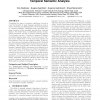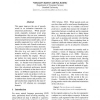49 search results - page 8 / 10 » An Empirical Study on Class-Based Word Sense Disambiguation |
WWW
2011
ACM
13 years 2 months ago
2011
ACM
Computing the degree of semantic relatedness of words is a key functionality of many language applications such as search, clustering, and disambiguation. Previous approaches to c...
ACL
2010
13 years 5 months ago
2010
This paper improves the use of pseudowords as an evaluation framework for selectional preferences. While pseudowords originally evaluated word sense disambiguation, they are now c...
ECML
2003
Springer
14 years 25 days ago
2003
Springer
Comparative machine learning experiments have become an important methodology in empirical approaches to natural language processing (i) to investigate which machine learning algor...
NLPRS
2001
Springer
14 years 1 days ago
2001
Springer
We propose a new ensembling method of Support Vector Machines (SVMs) based on Feature Space Restructuring. In the proposed method, the weighted majority voting method is applied f...
SAC
2009
ACM
14 years 2 months ago
2009
ACM
Incorporating background knowledge into data mining algorithms is an important but challenging problem. Current approaches in semi-supervised learning require explicit knowledge p...


